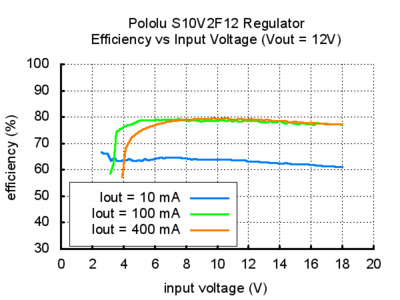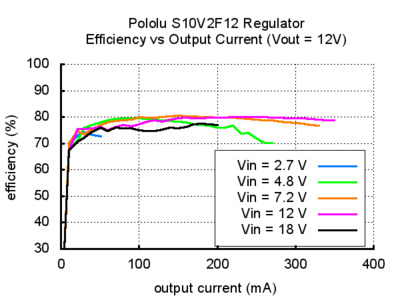12V Step-up/Step-Down Voltage Regulator
12V Step-up/Step-Down Voltage Regulator
Out of Stock

About this product
This micro sized step-up/step-down voltage regulator is perfect for supplying 12v power (from a higher voltage source like 4s or 5s Lipo or even a lower voltage like 2s or 3s) to your FPV gear that needs specifically 12v power. Power 12v flight cameras, LED lights or other gear that can only run on 12v.
This switching regulator uses the SEPIC topology to produce 12 V from input voltages between 2.5 V and 18 V. The wide input range coupled with its ability to convert both higher and lower input voltages makes it useful for applications where the power supply voltage can vary greatly, as with batteries that start above but discharge below 12 V. The compact (0.4″ × 0.575″) module can supply over 200 mA in typical applications.
Features
- Input voltage: 2.5 V to 18 V (can be higher than, the same as, or lower than the 12 V output)
- Fixed 12 V output with 4% accuracy
- Typical continuous output current: 200 mA (Up to 300 mA on 4s battery)
- <2 mA typical no-load quiescent current
- Integrated over-temperature shutoff
- Small size: 0.40″ × 0.575″ × 0.1″ (10 mm × 15 mm × 3 mm)
During normal operation, this product can get hot enough to burn you. Take care when handling this product or other components connected to it.
Connections
This step-up/step-down regulator has four connections: shutdown (SHDN), input voltage (VIN), ground (GND), and output voltage (VOUT).
The SHDN pin can be driven low (under 0.4 V) to power down the regulator. The quiescent current in this shutdown mode is dominated by the current in the 10 kΩ pull-up resistor fromSHDN to VIN. With SHDN held low, this resistor will draw 0.1 mA per volt on VIN (for example, the shutdown current with a 5 V input will be 0.5 mA). This pin should only ever be driven low or left floating; this can be accomplished with a physical switch that toggles it between ground and disconnected, or electrically with something like a transistor controlled by an I/O line.
The input voltage should be between 2.5 V and 18 V. Lower inputs can shut down the voltage regulator; higher inputs can destroy the regulator, so you should ensure that noise on your input is not excessive and be wary of destructive LC spikes (see below for more information).
The four connections are labeled on the back side of the PCB, and they are arranged with a 0.1″ spacing along the edge of the board for compatibility with standard solderless breadboards and perfboards and connectorsthat use a 0.1″ grid. You can solder wires directly to the board or solder in either the 4×1 straight male header strip or the 4×1 right-angle male header strip that is included.
Typical Efficiency and Output Current
The efficiency of a voltage regulator, defined as (Power out)/(Power in), is an important measure of its performance, especially when battery life or heat are concerns. As shown in the graphs below, this switching regulator typically has an efficiency of 70% to 80%.
 |
More Information
| SKU | 1400 |
|---|---|
| UPC (GTIN) | 744881752381 |
| Manufacturer | Pololu |
| NDAA Compliant | No |
| Item Returns | This item can be returned |


